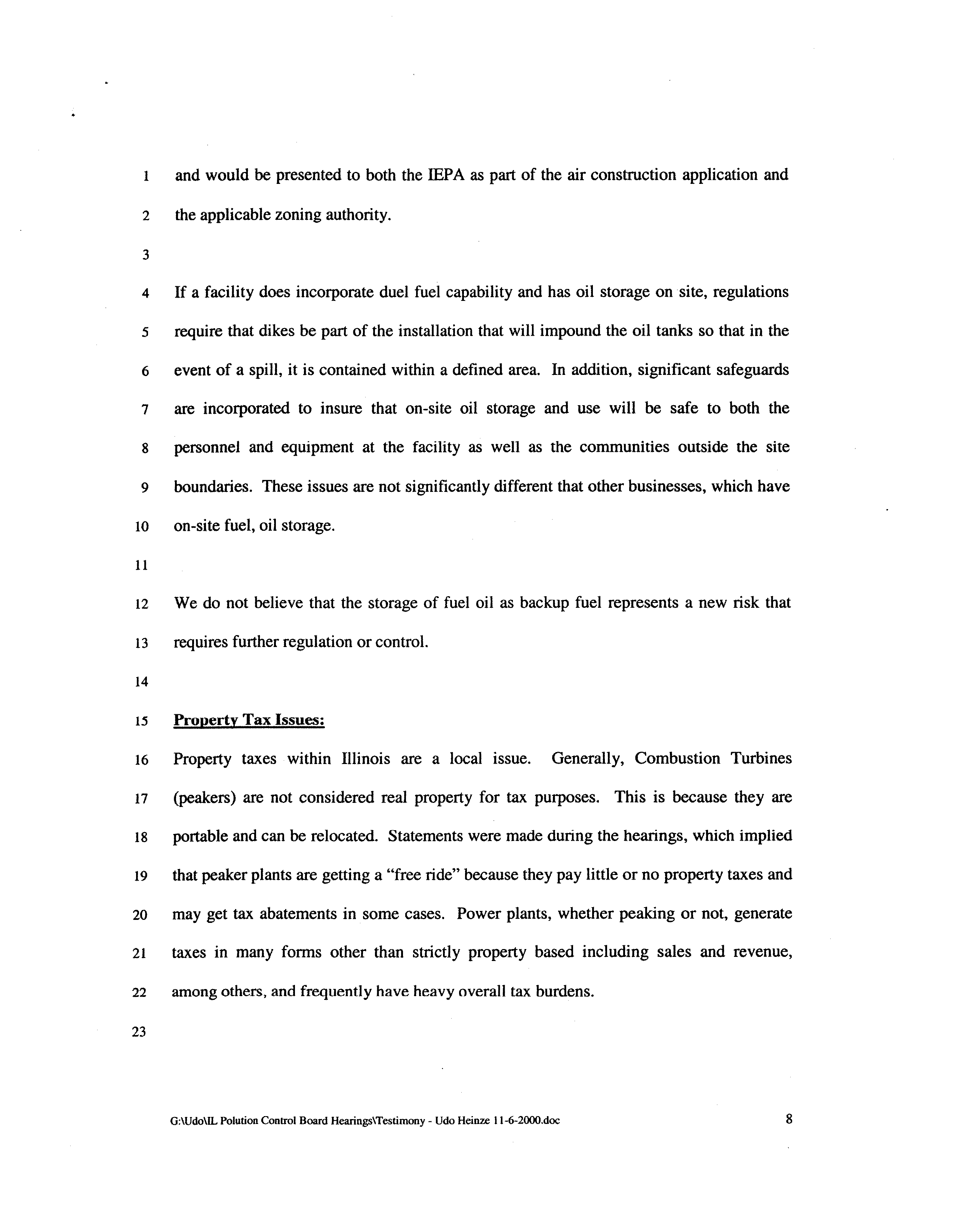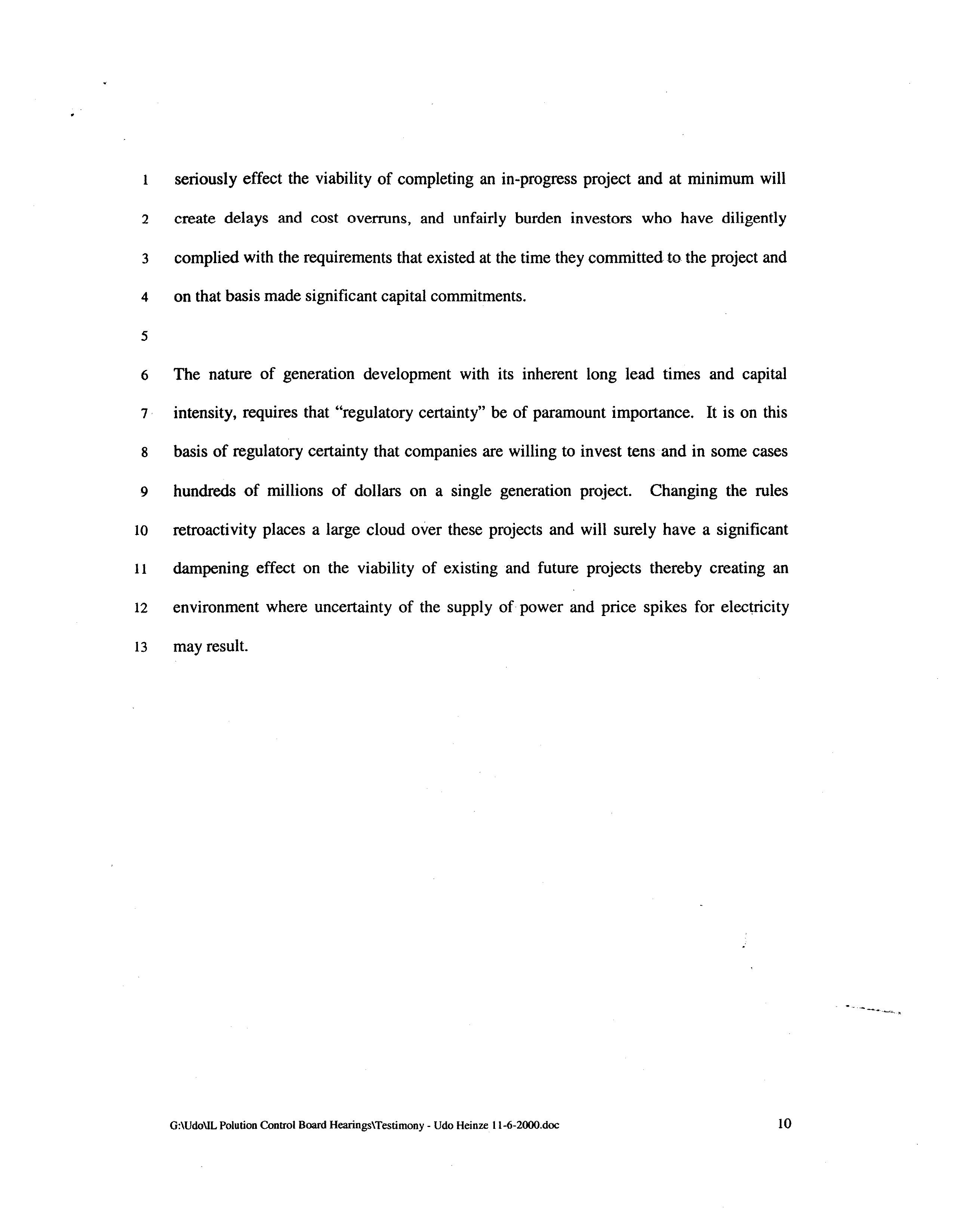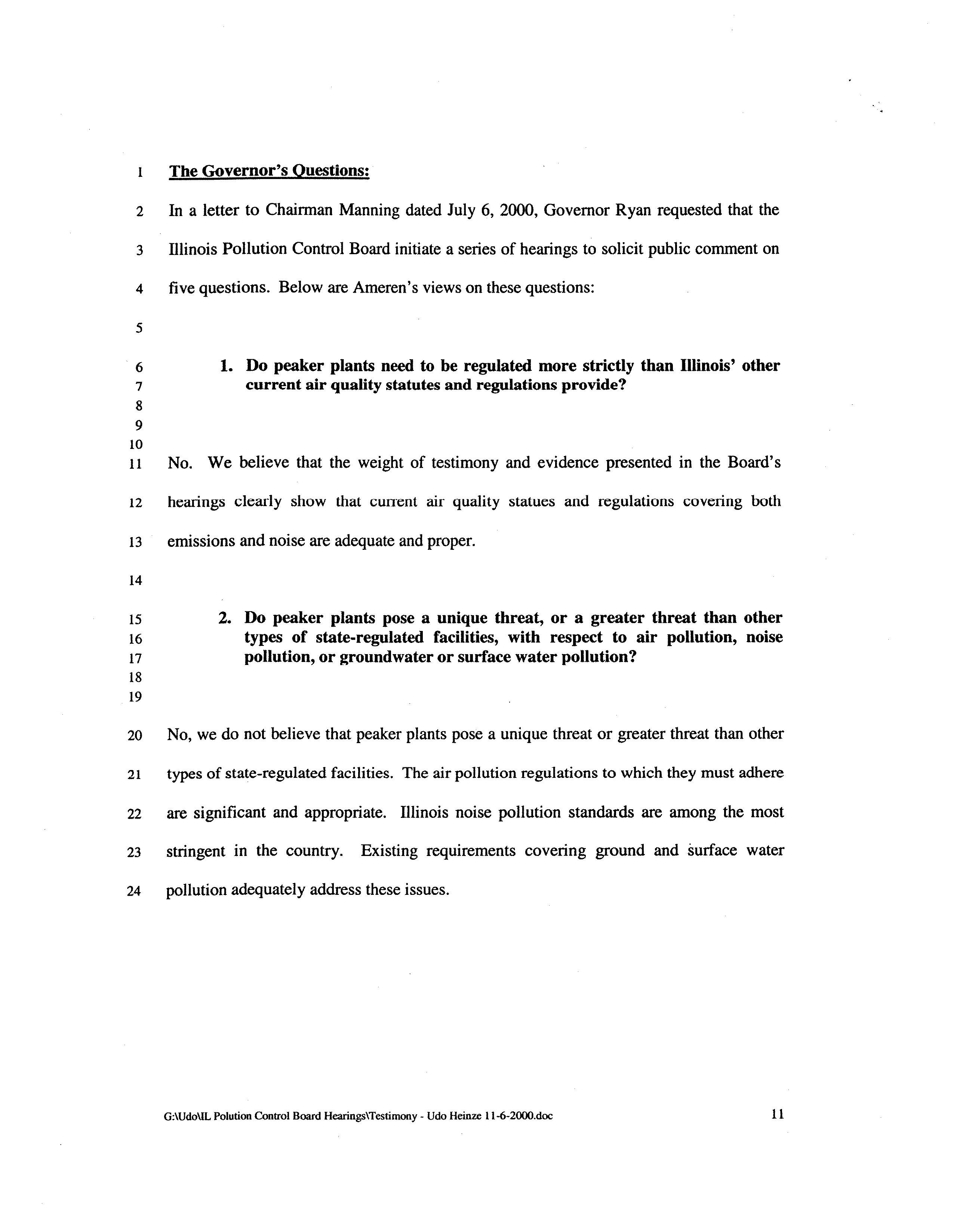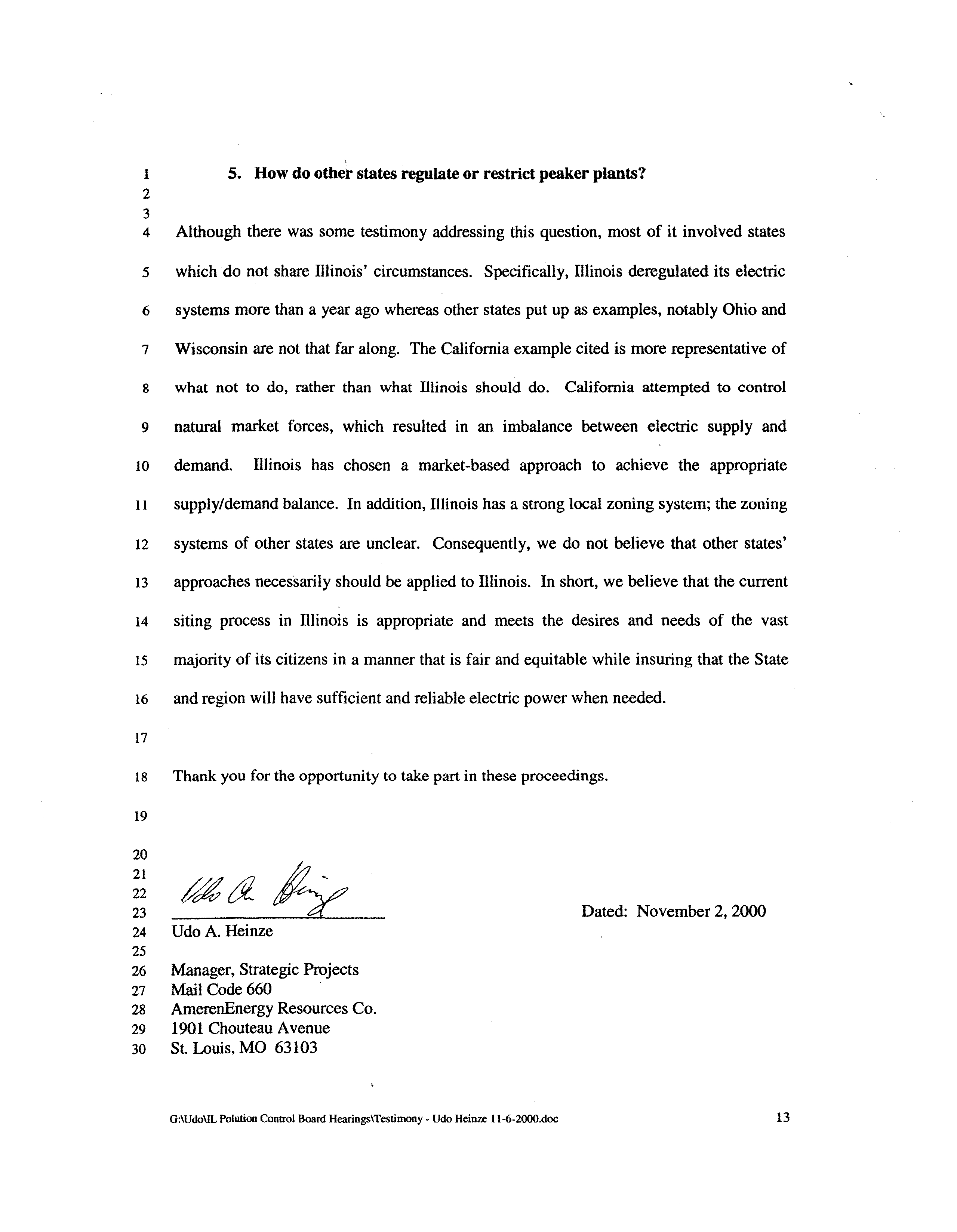Resources
One Ameren Plaza
1901 Chouteau Avenue
P0 Box
66149
St. Louis,
MO 63166-6149
314fi54.45fl6
314.5543066 fax
wwwamereneaergycorn
November 2,
2000
Illinois Pollution Control Board
Ms. Dorothy Gunn
Clerk
100
West Randolph Street, Suite 11-500
Chicago, IL
60601
RE:
Written Comments to IPCB docket number ROl-lO.
Dear Ms Gunn:
ftECE~V~D
CLER!’S
OFp7rr
NOV
0
6
2000
STATE
OF IWNOIS
Pollution Controf Boord
/
-~
Enclosed is Ameren Corporation’s written comments in the above referenced docket.
Thank you for your attention to this matter.
Very truly yours,
Udo A. Hcinze
Manager, Strategic Projects
AmerenEnergy Resources Company
Enclosure
I
RECEIVED
ILLINOIS POLLUTION CONTROL BOARD
CLERK’S
OFFICE
NOV
08
2000
4
IN THE MATFER OF
)
STATE OF IWNOIS
5
)
Pollution Control
Board
6
NATURAL GAS-FIRED, PEAK LOAD
)
ROl-lO
i
EELECTRICALPOWER GENERATING
)
8
FACILITIES (PEAKER PLANTS)
)
9
10
WRITTEN COMMENTS
of UDO A. HEINZE
11
ON BAHALF
of AMEREN
CORPORATION
12
13
My
name
is
Udo A
Heinze
I
am
manager
of Strateg~~ojects
for
AmerenEnergy
14
Resources
Company’s
development
group.
AmerenEnergy
~
was
15
formed in 2000,
is part of the Ameren
family of companies
and is a holding company.
16
One
of
its
subsidiaries
is
AmerenEnergy
Generating
Company,
which
assumed the
17
electric
generating
assets
of
AmerenCiPS.
AmerenEnergy
Resource
Company’s
18
development
group
has
responsibility
for
developing a number of
generating
facilities
-
19
within
the
state of illinois.
Upon commercialization, these facilities will become part
of
20
AmerenEnergy Generating Company.
21
22
In
my
current position I am directly involved in the development of generating projects
23
for AmerenEnergy Resources.
I have been employed by the Ameren companies (and one
24
of its predecessor companies, Union Electric) for over 28 years in a variety of positions.
25
I
hold a bachelor’s in Mechanical
Engineering and a Master of Business Administration
26
degrees
and
am a
registered
professional engineer in
the
State
of Missouri.
I
am
a
27
resident of Monroe County, IL.
G:\Udo\IL PolutionControl
Board
Hearings\Tcstimony
-
Udo Heinze
I l-6-2000.doc
1
1
The
purpose
of my
testimony
is
to
address
various
issues
raised
during
the
Illinois
2
Pollution Control Board hearings on “peaker plants”.
I have
personally attended several
3
sessions of these hearings and have studied the transcripts.
I think the board should
be
4
commended
on its very thorough process of seeking diversified input to the peaker plant
5
issues raised by Governor Ryan
andthe subject of these hearings.
As is evident from the
6
record, everyone
who wanted to present his or her views was given ample opportunity to
7
doso.
8
9
My comments will focus on the following areas:
10
1.
Emissions
ii
2.
Siting
12
3.
Water
13
4.
Hazardous materials on plant sites
14
5.
Property
Tax
issues
is
6. New Rule Applicability
16
7.
TheGovernor’s Questions
17
18
Emissions:
19
Much of
the
testimony
in
these
hearings
centered on
the
emissions
emanating
from
a
20
“peaker facility”; primarily NOx and its impacton ozone formation.
NOx emissions will
21
be strictly controlled and capped under a new “NOx SIP Call” regulation currently being
22
reviewed by the Illinois Pollution Control Board (IPCB).
This
new
regulation will
assure
23
that ambient air quality standards for ozone
will
be met
throughout
the state, including
G:\Udo\IL Polution
Control
Board
Heaiings\Testimony
-
Udo Heinze
II
-6-2000.doc
2
1
the
Chicago
area. Since NOx
emissions
will
be “capped” in the
State,
all
existing and
2
new peaker plants within the State will have to keep their emissions under the cap.
3
4
S02
emissions
in
the
State
are
already
capped
under
the
existing Federal Acid
Rain
5
program.
In
addition, these
sources are subject
to existing
State
and Federal
emission
6
standards.
Thus,
there
is
no
need
for
additional
requirements
to
control
these
air
7
emissions from peaker units.
8
9
Most of the new peaker plants in the State are simple cycle gas-fired combustion turbines
10
that
must meet annual emission
limits.
As
a matter
of economics,
the
owners of these
ii
facilities
are
striving
to
achieve
the
lowest
possible
NOx
emission
rates
to
allow
the
12
facility to operate a sufficient number of hours to earn an adequate return on
investment.
13
The lower the actual
emission rates, the more
likely the investment
will
be worthwhile.
14
This
is
a
marketplace
mechanism
that
encourages
the
use
of
cost
effective
control
15
technology.
16
17
As
part
of
the
air
permit
application
process,
air
quality
modeling
is
conducted
to
18
demonstrate
that the
new
facility
will
not have a significant
impact
on
air
quality.
A
19
significant impact is an extremely low
threshold, far below any threat to public health or
20
the environment.
If a new
facility has a significant
impact on air quality,
it must
apply
21
additional pollution control equipment or the
permit
is rejected.
22
G:~Udo\lL
Polution
Control
Board Heanngs\Testimony
-
Udo Heinze
I 1-6--2000.doc
3
1
There was some discussion at the hearings regarding the need to have new peaker plants
2
apply Best Available
Control Technology (BACT) or Lowest
Achievable Emission Rate
3
(LAER) controls.
For sources that exceed the
major source threshold, such
as base load
4
plants or intermediate load plants,
these technologies
are already required as a matter of
5
law.
For simple-cycle gas turbines,
the installation of add-on BACT or
LAER pollution
6
control equipment
is simply not practical
from a technical
viewpoint, or
it
is extremely
7
expensive. If such add-on controls were
to be required by the IPCB, it might have a (1)
8
negative effect on
air quality and will have a (2) negative effect on meeting the electrical
9
generation
needs
within
the
State.
This
is because
the
added
expense
to
units,
which
10
were
designed to
operate a maximum
of only
10-15
percent
of the
time,
would
make
ii
these units uneconomical to build and operate.
The probable market reaction would be to
12
either not
build
these
small
simple-cycle peaker
facilities
and
risk
power
shortages
at
13
critical
times,
or
to
build
larger
units,
where
such
additional
expense
might
be
cost-
14
justified.
However, the effect on air quality of these larger units would be worse (greater
15
overall
emissions),
and the
cost
of electricity would
be
unnecessarily higher.
Thus
it
16
could discourage development
of
an already very clean source of new power within
the
17
State
and encourage
the
development of higher
emitting generating
facilities,
or worse
18
yet, result in
insufficient generating capacity,
power market price spikes or shortages of
19
power.
20
21
There were also some concerns raised in the hearings regarding emissions during startup
22
of
these peaker plants.
While mass
emissions during startup conditions might be slightly
23
higher than
normal
operations,
they
are
still
extremely
low
and
of
short duration.
A
G:\Udo~1L
Polution
Control Board
Hearings\Testimony
-
Udo Heinze
II
-6-2000.doc
4
1
simple cycle gas turbine usually takes from
10 to 30 minutes to reach normal
operating
2
conditions. The
Illinois Environmental Protection Agency (IEPA) has already instituted a
3
process in
the
permitting of
new
peaker plants
to
account
for
the
slightly higher mass
4
emissions
that
may occur during
startup
conditions.
Thus,
there is
no
need,
nor
any
5
practical benefit,
to establish
more
rigid requirements
for startup conditions
for peaker
6
plants.
7
8
It has been well documented in these proceedings that the air permitting
process required
9
by
the IEPA includes
significant review of a proposed facility including the modeling of
10
air quality emissions.
The
purpose of this review and modeling is to determine the level
ii
of emissions expected from the proposed facility and its impact
on
the area in
which it
12
will be located.
Based on
the
level of emissions
and modeling results, the IEPA makes a
13
determination
of
whether the
proposed
facility
should
be considered a
significant
new
14
source or not.
The IEPA determination establishes the criteria under which it
will issue
15
an air construction permit for the proposed installation.
16
17
We
believe
that
the
combination
of
current
procedures
in
place
and
marketplace
18
mechanisms
appropriately
balance the environmental requirements
and adequacy of the
19
supply of electricity to meet requirements at the
most critical times of the year.
Further,
20
we believe that the requirement that significant modification requires an existing facility
21
obtain
a new
environmental review by IEPA prior to implementing such modifications is
22
just
and proper.
It
is the IEPA’s
responsibility to
insure those projects
meet
State and
G:\Udo\lL Polution Control Board
Heanngs\Testimony
-
Udo Heinze
I l-6-2000.doc
5
p
1
Federal environmental regulations.
It is the applicant’s responsibility to insure that they
2
operate their facilities within the terms of their permits.
3
4
Siting:
5
Prior to
electric
deregulation in
Illinois,
authority for the
siting
of generating facilities
6
resided with the Illinois Commerce Commission.
Part of that authority included not only
7
authorizing the construction of the proposed generating facility at a specific site but also
8
conveying
to
the
developer
the
right
of
eminent
domain
in
obtaining
the
necessary
9
property
for
such
development.
Such
authority
superceded
any
authority
at the
local
10
level.
This
existed to assure the right type of facility was built at the optimum location
ii
from a transmission and load requirements standpoint.
12
13
Since
electric
deregulation,
there
is
no
longer
any
review
required
by
the
Illinois
14
Commerce Commission on proposed generation developments.
Site selection is up to the
15
developer
provided
that
local
zoning
boards
concur with
the
specific
site
selected
and
16
issue the required zoning
permit.
Control of siting has effectively
been transferred from
17
the
centralized State
level
to the
local
level, however,
with one notable exception.
The
18
right of
eminent
domain
did
not
follow
the
transfer
to
the
local
level.
Hence,
the
19
developer must obtain
the sought
after site under normal
business
arrangements, rather
20
then through a taking under eminent domain.
Control is again at the local
level.
If the
21
property
can not be obtained, then the developer has
no recourse.
The deregulation law
22
recognized that the marketplace is the mechanism that will provide the necessary balance
23
between the various stakeholders.
G:\Udo~IL
Polution Control Board Hearings\Testimony
-
Udo
Heinze
I i-6-2000.doc
6
I
We
believe
that zoning should be
a local
issue, not
imposed
by
a state agency.
Local
2
officials are in a much better position to represent the desires of their constituents on the
3
siting of facilities
within
their jurisdictions
than
would be
the case under
a centralized
4
State agency in Springfield.
5
6
Water:
7
Water is a significant
issue
throughout Illinois not just
in
the counties comprising
and
8
surrounding Chicago.
Although
we have
successfully dealt with
this issue at the
local
9
level
concerning
generating projects
outside
the Chicago area,
from
the
testimony it
is
10
clear that for some high-density areas water usage may be a broader issue.
In those cases
11
the issues
involved may encompass more that just the
local water
district balancing
the
12
needs
of its constituents.
Consequently,
for
those areas,
it may be
prudent to
consider
13
water usage
on
a regional
rather
then purely
local
basis
if that
is the
conclusion
of the
14
Board.
15
16
Hazardous Materials on Plant Site:
17
During the hearings concerns were raised by nearby residents on the storage of oil at
18
peaker
plant sites.
Oil
is
generally used
as a backup fuel
for the combustion
turbines.
19
Many facilities, including generating plants, have had on-site fuel storage for decades.
In
20
the case of peaker plants the normal fuel used is natural
gas which, of course, is supplied
21
by
pipeline and not stored on
site.
Normally peaker
units
utilize
either No.
1
or No.
2
22
fuel
oil
as
the
backup
fuel.
However,
not
all
peaker
facilities incorporate
backup
fuel
23
capability.
In those
instances where they do,
it
becomes part
of the permitting process
Cl:~Udo~lL
Polution Control Board Hearings\Testimony
-
Udo Heinze
11
-6-2000doc
7
1
and
would be presented to both the IEPA as part of the air construction
application and
2
the applicable zoning authority.
3
4
If a facility
does incorporate duel fuel capability
and has oil storage
on
site, regulations
5
require that dikes
be part of the installation that will impound the oil tanks so that in the
6
event of a spill, it is contained within a defined area.
In
addition, significant safeguards
7
are
incorporated
to
insure
that
on-site
oil
storage
and
use
will
be
safe
to
both
the
8
personnel
and equipment
at the
facility
as
well
as
the
communities
outside
the
site
9
boundaries.
These issues
are not significantly different that other businesses,
which have
10
on-site fuel, oil storage.
11
12
We
do not believe
that the
storage of fuel oil as backup fuel represents a new risk that
13
requires further
regulation or control.
14
15
Property Tax Issues:
16
Property
taxes
within
Illinois
are
a
local
issue.
Generally,
Combustion
Turbines
17
(peakers) are
not considered
real
property
for tax
purposes.
This
is
because they
are
18
portable and can be relocated.
Statements were made during the hearings, which implied
19
that peaker plants are getting a“free ride” because theypay little or no property taxes and
20
may get tax
abatements in
some cases.
Power plants,
whether peaking or not,
generate
21
taxes
in
many forms
other
than
strictly
property
based
including
sales
and
revenue,
22
among others, and frequently have heavy overall tax burdens.
23
(i:\Udo\lL
PolutionControl Board Heariags\Testimony
-
Udo Heinze Ii
-6-2000.doc
8
1
We believe that the local taxing authority is the appropriate jurisdiction to address these
2
issues. The level of tax burden is,
and should be, determined by the
local taxing authority
3
and such tax
burden can be significant.
The
same
is true of tax abatements.
It is ~
a
4
foregone conclusion
that
all proposed peaker plants
will
obtain tax
abatements
—
many
5
have not.
6
7
New Rule Applicability:
8
Generating
facilities by their nature
are
complex
apparatus.
In
addition,
the
major
9
equipment, turbines,
generators,
control
systems and transformers are long lead-time
10
items requiring up to
a year or
more
after procurement,
for delivery.
This
lead-time
11
frequently takes longer than
the
permitting
process.
Construction
of a
peaker
facility
12
typically takes 2-3
years
from
project
initiation
to
actual
commercialization.
Noise
13
abatement,
emission
limitations
and performance
enhancements
need
to
be
engineered
14
into
the
project
up-front.
In
many cases retrofitting
technologies
after the
facility
has
15
been constructed is neither economic nor practical.
16
17
As regulations governing facilities change,
it is more reasonable that those changes apply
18
to
facilities that
have
not
committed
to
purchase
orders
for equipment
rather
than
to
19
facilities already completed or in the process thereof.
Upon committing to
the purchase
20
of, major
equipment,
the
specifications
for
that
portion
of
the
facility’s
design
have
21
usually been established.
And, once the appropriate permits have been issued and actual
22
construction begun, a majority of the design parameters have been
set and the majority of
23
the project cost has
been
committed.
Imposing new
standards applied retroactively can
G:\Udo”JL Polution Control Board Heaxings\Testimony
-
Udo
Heinac
I
I-6-2000.doc
9
1
seriously
effect the
viability of completing
an
in-progress project
and at minimum
will
2
create
delays
and
cost
overruns,
and
unfairly
burden
investors
who
have
diligently
3
complied with the requirements that existed at the
time they committed to the project and
4
on that basis made significant capital commitments.
5
6
The
nature
of
generation
development
with
its
inherent
long
lead
times
and
capital
7
intensity, requires that “regulatory certainty” be of paramount
importance.
It is on
this
8
basis of regulatory certainty that companies are willing to invest tens and in some cases
9
hundreds
of millions
of
dollars
on
a
single
generation
project.
Changing
the
rules
10
retroactivity
places
a large cloud over
these projects and will
surely have a significant
11
dampening
effect
on
the
viability
of
existing and
future
projects
thereby creating
an
12
environment
where
uncertainty
of the
supply
of power
and price spikes
for electricity
13
may result.
G:\Udo~IL
Polution Control BoardHearings~Testimony
-
Udo
Ueinze
I l-6-20004oc
10
1
The Governor’s Ouestions:
2
In
a letter
to
Chairman
Manning dated July
6,
2000, Governor Ryan requested that the
3
illinois Pollution Control Board initiate a series of hearings to solicit public comment on
4
five questions.
Below are Ameren’s views on these questions:
5
6
1.
Do peaker
plants
need
to
be regulated
more strictly than
Illinois’
other
7
current
air
quality statutes and regulations provide?
8
9
10
ii
No.
We
believe
that
the
weight of testimony
and
evidence presented in the Board’s
12
hearings
clearly
show
that
current
air
quality
statues
and
regulations
covering
both
13
emissions and noise are adequate and proper.
14
15
2.
Do peaker
plants
pose
a
unique
threat,
or
a
greater
threat
than other
16
types
of
st.ate-regulated
facilities,
with
respect
to
air
pollution,
noise
17
pollution, or groundwater or surface water pollution?
18
19
20
No,
we do
not believe that peaker plants pose a unique threat or
greater threat than other
21
types
ofstate-regulated facilities. The air pollution regulations to which
they must adhere
22
are
significant
and appropriate.
Illinois
noise
pollution
standards
are
among the
most
23
stringent
in
the
country.
Existing
requirements
covering
ground
and
surface
water
24
pollutionadequately address these issues.
G:~Udo\IL
Polution
Control Board Hearings\Testimony
-
Udo Heiaze
1 I-6-2000.doc
11
1
3.
Should new or expanding peaker plants be subject to siting requirements
2
beyond applicable local zoning requirements?
3
4
5
No. We believe that local zoning requirements
are
sufficient
and
that
the
local zoning
6
process has worked as it was designed.
Local zoning officials
are best suited to
ascertain
7
the
desires of their constitutes
on
zoning
issues.
This
has
resulted in
some
proposed
8
peaker
projects being accepted
by
local zoning boards and the communities
within they
9
reside, and the denial of some proposedpeaker projects by the local zoning
boards.
The
10
system appears to be working theway it was envisioned.
11
12
4.
If
the
Board
determines
that
peaker
plants
should
be
more
strictly
13
regulated or restricted, should additional regulations or restrictions apply
14
to currently permitted facilities or only to
new facilities and expansions?
15
16
17
We believe strongly
that
any
new
regulations or
restrictions should
be
applicable
on
a
18
date-certain
basis,
prospectively
applied.
Retroactive
application
would
be
grossly
19
unequitable to the affected businesses that are attempting to supply
much needed energy
20
and
electric
capacity
to
consumers.
In
determining
the
applicability
of
such
new
21
regulations or restrictions, the date of purchase of the impacted equipment should govern.
22
As
previously
stated
the
lead-time
for
new
equipment
can
exceed
a
year.
This
23
application is consistent with
how
such
rules
are applied
on the
federal
level
under the
24
NSPS program.
G:\Udo~ILPolution Control Board Hearings\Testimony
-
Udo
Heinze
II -6-2000doc
12
5.
How do other states regulate or restrict peaker plants?
1
2
3
4
Although
there was
some testimony
addressing this question,
most of
it involved states
5
which do not share illinois’
circumstances.
Specifically, Illinois deregulated its electric
6
systems more than a year ago whereas other states put up as examples, notably Ohio
and
7
Wisconsin
are not that far along.
The California example cited is more representative of
8
what
not
to
do,
rather
than
what
Illinois
should
do.
California
attempted
to
control
9
natural
market
forces,
which
resulted
in
an
imbalance
between
electric
supply
and
10
demand.
Illinois
has
chosen
a
market-based
approach
to
achieve
the
appropriate
11
supply/demand
balance.
In addition, Illinois has a strong local
zoning system; the zoning
12
systems of other states are unclear.
Consequently, we do
not believe
that other states’
13
approaches necessarily should be
applied to Illinois.
In
short, we believe that the current
14
siting
process
in
Illinois
is appropriate and meets the desires and needs of the
vast
15
majority
of its citizens in a manner that is fair and equitable while
insuring
that the State
16
and region
will have sufficient and reliable electric power when needed.
17
18
Thank you for the opportunity to take part
in these proceedings.
19
23
_________________________
Dated:
November 2, 2000
24
Udo A. Heinze
25
26
Manager, Strategic Projects
27
Mail Code 660
28
AmerenEnergy Resources Co.
29
1901
Chouteau Avenue
30
St. Louis,MO 63103
G:~Udo”lL
Polution Control Board Heanngs~Testimony
-
Udo Heinze
1 I-6-20004oc
13














